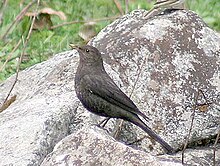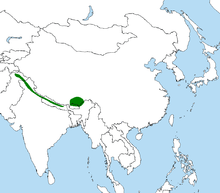Tibetan blackbird
| Tibetan blackbird | |
|---|---|

| |
| A female | |

| |
| A male | |
| Scientific classification | |
| Kingdom: | Animalia |
| Phylum: | Chordata |
| Class: | Aves |
| Order: | Passeriformes |
| Family: | Turdidae |
| Genus: | Turdus |
| Species: | T. maximus
|
| Binomial name | |
| Turdus maximus Seebohm, 1881
| |

| |
| Synonyms | |
| |
The Tibetan blackbird (Turdus maximus) is a species of bird in the thrush family Turdidae. It was formerly considered a subspecies of the common blackbird. It is found in the Himalayas from northern Pakistan to southeastern Tibet.
Taxonomy and systematics[]
The Tibetan blackbird was originally described as Merula maxima by Henry Seebohm in 1881 on the basis of a specimen collected by Thomas Jerdon in Gulmarg, Kashmir.[2][3] The generic name Turdus is from the Latin turdus, meaning thrush, while the specific name maximus is from the Latin maximus, meaning greatest.[4]
The Tibetan blackbird is one of 65 species in the genus Turdus. It was previously treated as a subspecies of the common blackbird (Turdus merula). However, phylogenetic studies have shown the Tibetan blackbird to be only distantly related to the common blackbird, with the species instead being sister to Kessler's thrush.[5] Richard and Annie Meinertzhagen described a proposed subspecies buddae on the basis of the smaller bills of birds in Sikkim and Gyangtse in 1925, but this character is not consistent throughout the population, and the species is consequently treated as being monotypic.[6][7]
Description[]
It is a relatively large thrush, being 23–28 centimetres (9–10 inches) in length.[7] It differs from the common blackbird by its complete lack of eye-ring and reduced song.[7]
Distribution and habitat[]
The Tibetan blackbird is found locally in the Himalayas of India, Pakistan, Nepal, Bhutan, and China. During the breeding season, it inhabits steep grassy, rocky slopes and alpine meadows just above the tree line at elevations of 3,200–4,800 m (10,500–15,700 ft). In the winter, it descends to lower elevations, but rarely goes below 3,000 m (9,800 ft).[7]
Behaviour and ecology[]
Diet[]
The Tibetan blackbird is omnivorous, feeding on earthworms, molluscs, insects, small lizards, fruit, and seeds. It forages on the ground, hopping over rocks and boulders, and favours soft bare ground at the edge of melting snow for foraging. In late summer, foraging occurs in flocks of up to ten individuals.[7]
Breeding[]
The Tibetan blackbird's breeding season lasts from May to July, with breeding peaking from June to early July. Breeding occurs in juniper or rhododendron bushes. It builds a bulky cup nest with mud, animal hair, and fine grass. Nests are built in roots on the ground, at the foot of a boulder, in low bushes, on cliff faces, or against rocky walls. was the favourite plant for building nests in China. Eggs are large and dull buff to grey with brown blotches, and are laid in clutches of three or four. The time taken to incubate the eggs is 12–13 days and the time it takes for nestlings to fledge is 16–18 days. Nestlings are fed small worms. A study in China found the success rate of nests to be 59%.[7][8]
Status[]
The Tibetan blackbird is listed as being of least concern by the International Union for Conservation of Nature (IUCN) on the IUCN Red List due to its very large range, large population, and a stable population that appears to be increasing.[1]
References[]
- ^ a b BirdLife International (2018). "Turdus maximus". IUCN Red List of Threatened Species. 2018: e.T103892028A132202298. doi:10.2305/IUCN.UK.2018-2.RLTS.T103892028A132202298.en. Retrieved 18 November 2021.
- ^ Seebohm, Henry (1881). Catalogue of the Birds in the British Museum. 5. London. p. 405.
- ^ British Ornithologists' Club (1925). Bulletin of the British Ornithologists' Club. 46. London: British Ornithologists' Club. p. 98.
- ^ Jobling, James A. (2010). Helm Dictionary of Scientific Bird Names. London: Christopher Helm. pp. 244, 393. ISBN 978-1-4081-3326-2.
- ^ Nylander, Johan A. A.; Olsson, Urban; Alström, Per; Sanmartín, Isabel (2008-04-01). Baker, Allan (ed.). "Accounting for Phylogenetic Uncertainty in Biogeography: A Bayesian Approach to Dispersal-Vicariance Analysis of the Thrushes (Aves: Turdus)". Systematic Biology. 57 (2): 257–268. doi:10.1080/10635150802044003. ISSN 1076-836X.
- ^ "Thrushes – IOC World Bird List". Retrieved 2021-11-03.
- ^ a b c d e f Collar, Nigel (2020-03-04), Billerman, Shawn M.; Keeney, Brooke K.; Rodewald, Paul G.; Schulenberg, Thomas S. (eds.), "Tibetan Blackbird (Turdus maximus)", Birds of the World, Cornell Lab of Ornithology, doi:10.2173/bow.tibbla1.01, retrieved 2021-11-02
- ^ Lu, Xin (2005). "Reproductive ecology of blackbirds (Turdus merula maximus) in a high-altitude location, Tibet". Journal of Ornithology. 146 (1): 72–78. doi:10.1007/s10336-004-0058-1. ISSN 0021-8375.
- IUCN Red List least concern species
- Turdus
- Birds of Pakistan
- Birds of North India
- Birds of Nepal
- Birds of Tibet
- Birds described in 1881
- Taxa named by Henry Seebohm

